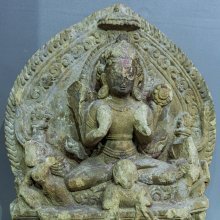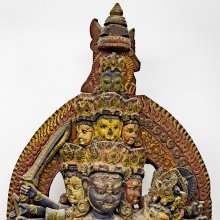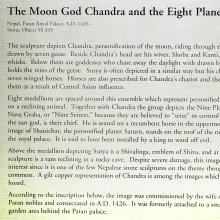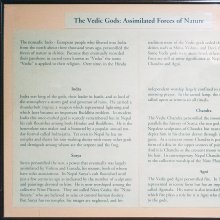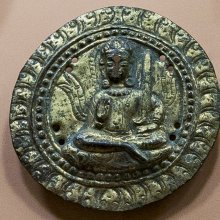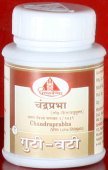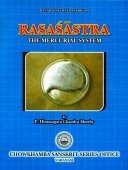Chandra: 4 definitions
Introduction:
Chandra means something in the history of ancient India, Hindi, biology. If you want to know the exact meaning, history, etymology or English translation of this term then check out the descriptions on this page. Add your comment or reference to a book if you want to contribute to this summary article.
Ambiguity: Although Chandra has separate glossary definitions below, it also represents an alternative spelling of the word Candra. It further has the optional forms Chandrā and Chāndra.
Images (photo gallery)
(+11 more images available)
India history and geography
Source: Project Gutenberg: Castes and Tribes of Southern India, Volume 11) Chandra (“moon”) or Chandra Sishta or Suchandra or Vannavamsam is one of the exogamous septs (divisions) among the Komatis (a trading caste of the Madras Presidency). The Komatis are said to have originally lived, and still live in large numbers on the banks of the Godavari river. One of the local names thereof is Gomati or Gomti, and the Sanskrit Gomati would, in Telugu, become corrupted into Komati. The sub-divisions are split up into septs (viz., Chandra), which are of a strictly exogamous character.
2) Chandra (“moon”) is one of the exogamous septs (divisions) among the Kurubas (a tribe of South India). The Kurubas are sub-divided into clans or gumpus, each having a headman or guru called a gaudu, who gives his name to the clan. And the clans are again sub-divided into gotras or septs (viz., Chandra).

The history of India traces the identification of countries, villages, towns and other regions of India, as well as mythology, zoology, royal dynasties, rulers, tribes, local festivities and traditions and regional languages. Ancient India enjoyed religious freedom and encourages the path of Dharma, a concept common to Buddhism, Hinduism, and Jainism.
Biology (plants and animals)
Source: Wisdom Library: Local Names of Plants and DrugsChandra [चन्द्र] in the Sanskrit language is the name of a plant identified with Tinospora cordifolia from the Menispermaceae (Moonseed) family. For the possible medicinal usage of chandra, you can check this page for potential sources and references, although be aware that any some or none of the side-effects may not be mentioned here, wether they be harmful or beneficial to health.
Chandra [चन्द्रा] in the Hindi language is the name of a plant identified with Paeonia emodi Royle from the Paeoniaceae (Peony) family.
Chandra in the Sanskrit language, ibid. previous identification.
Chandra in the Telugu language is the name of a plant identified with Senegalia chundra (Roxb. ex Rottler) Maslin from the Mimosaceae (Touch-me-not) family having the following synonyms: Acacia chundra, Mimosa chundra, Acacia sundra.
Source: Google Books: CRC World Dictionary (Regional names)1) Chandra in India is the name of a plant defined with Litsea glutinosa in various botanical sources. This page contains potential references in Ayurveda, modern medicine, and other folk traditions or local practices It has the synonym Litsea sebifera Pers. (among others).
2) Chandra is also identified with Mimosa rubicaulis It has the synonym Mimosa octandra Roxb. (etc.).
3) Chandra is also identified with Paeonia emodi It has the synonym Paeonia emodi Wall. (etc.).
4) Chandra is also identified with Rauvolfia serpentina It has the synonym Ophioxylon salutiferum Salisb. (etc.).
Example references for further research on medicinal uses or toxicity (see latin names for full list):
· Regnum Vegetabile, or ‘a Series of Handbooks for the Use of Plant Taxonomists and Plant Geographers’ (1993)
· Encyclopédie Méthodique, Botanique (1783)
· Beautiful flowers of Kashmir (1928)
· Philippine Journal of Science (1911)
· Species Plantarum (1753)
· Journal of Cytology and Genetics (1990)
If you are looking for specific details regarding Chandra, for example diet and recipes, health benefits, chemical composition, side effects, pregnancy safety, extract dosage, have a look at these references.

This sections includes definitions from the five kingdoms of living things: Animals, Plants, Fungi, Protists and Monera. It will include both the official binomial nomenclature (scientific names usually in Latin) as well as regional spellings and variants.
Languages of India and abroad
Hindi dictionary
Source: DDSA: A practical Hindi-English dictionaryChandra in Hindi refers in English to:—(nm) the moon; crescent; ~[kala] lunar crescent; a digit of the moon (sixteenth part of the circumference); ~[kamta] moonstone; ~[grahana] lunar eclipse; ~[bimdu] the nasal sign represented by a crescent with a dot over it ([m]), as distinct from [anusvara] represented by a dot above the top ([m]); ~[bimba] the lunar disc; ~[mamdala] the halo of the moon; ~[mukhi] a woman blessed with a moon-like face; ~[loka] the sphere or heaven of the moon; ~[vamsha] the lunar race—one of the two major kshatriya dynasties that flourished in ancient India; ~[vamshi] belonging to the lunar dynasty ([candravamsha]); ~[vadana] blessed with a moon-like face; ~[vadani] a beauty blessed with a moon-like face; ~[vara] Monday; ~[bimdu] see [camdrabimdu]; ~[shekhara] Lord Shiv—whose head is said to be ever adorned by the presence of the lunar crescent; ~[hara] a kind of broad necklace..—chandra (चंद्र) is alternatively transliterated as Caṃdra.
...
See also (Relevant definitions)
Starts with (+250): Candrashekar, Chandra kaanthi, Chandra paada, Chandra podi, Chandra poliki, Chandra pushpa, Chandra Sishta, Chandra-hittu, Chandra-kaasi-soppu, Chandra-kantha, Chandra-kasi-soppu, Chandra-mali, Chandra-mallige, Chandra-mallika, Chandra-poda, Chandra-ung-aah, Chandra-vyakarana, Chandrabadanika, Chandrabala, Chandrabha.
Ends with (+85): Abhichandra, Amarachandra, Anachandra, Anandachandra, Anugrahachandra, Archishchandra, Arddhachandra, Ardhachandra, Ardhchandra, Asangamatichandra, Balachandra, Bhalachandra, Bhanushchandra, Bheshajachandra, Boda chandra, Bodachandra, Bodhimandavibuddhashrichandra, Chandanashrichandra, Charuchandra, Damachandra.
Full-text (+103): Amruthapala, Chandra-mallika, Varccas, Atri, Janakia arayalpathra, Rohini, Chandra pushpa, Boda chandra, Humboldtia unijuga, Chandra kaanthi, Chandra-mali, Chandra-poda, Chandra-ung-aah, Nalla chandra, Chandra-mallige, Chandra-kantha, Chandra poliki, Chandra podi, Candra, Chandra paada.
Relevant text
Search found 123 books and stories containing Chandra, Chandrā, Chāndra; (plurals include: Chandras, Chandrās, Chāndras). You can also click to the full overview containing English textual excerpts. Below are direct links for the most relevant articles:
Rasa Jala Nidhi, vol 5: Treatment of various afflictions (by Bhudeb Mookerjee)
Part 6 - Chemists of the Metallic School: Chandra Sena < [A Brief History of Indian Chemistry and Medicine]
Part 8 - Chemists of the Metallic School: King Rama Chandra < [A Brief History of Indian Chemistry and Medicine]
Part 4 - Chemists of the Metallic School: Introduction < [A Brief History of Indian Chemistry and Medicine]
The Shiva Purana (by J. L. Shastri)
Chapter 33 - March of The Victorious Lord Śiva < [Section 2.5 - Rudra-saṃhitā (5): Yuddha-khaṇḍa]
Preceptors of Advaita (by T. M. P. Mahadevan)
Related products
(+5 more products available)
